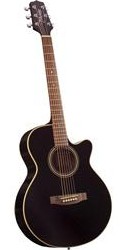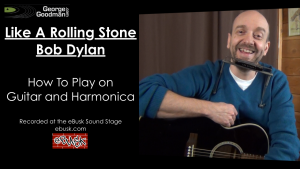Like A Rolling Stone – How To Play on Guitar and Harmonica – Quick Facts
Like A Rolling Stone was written and recorded by Bob Dylan in 1965 appearing on the Highway 61 Revisited album.
Consistently ranks as one of the top rock songs of all time.
Covered by The Rolling Stones, Jimi Hendrix, Johnny Winter, David Bowie and others.
Al Kooper played the organ on the original recording which gives the song much of its feel.
Musical Instruments and Recording Equipment
Takamine Acoustic-Electric EG Series Guitar

In this video I am playing a Takamine Electric Acoustic EG series guitar similar to the one pictured here.
It has a solid spruce top with nato back and sides and a rosewood fretboard with abalone fret markers.
The built-in Takamine TK-40 preamp features EQ Bypass, Notch Filter, Mid Contour, Bass, Mid, Treble and Gain in addition to a built-in electronic tuner.
This guitar performs great and records great.
Hohner 560 Special 20 Harmonica G

I’m using a Hohner Special 20 in the key of G for Like A Rolling Stone. The song is in the key of G so I’m playing harmonica in first position.
Hohner Harmonica Neck Holder

I made my first harmonica holder out of an old wire coat hanger. It wasn’t beautiful but it worked and put me on the road to earning my McGyver certificate at an early age.
For me now, a comfortable and properly fitting harmonica holder is a must for hands free harmonica playing. This
Hohner Harmonica Neck Holder works great for me.
Another harmonica holder that you may want to try that has gotten great reviews is the
Lee Oskar Harmonica Holder. You can also check out other harmonica holders on my George’s Harp Shop page.
Harmonica Tabs
This version of Like A Rolling Stone is in the key of G and I am playing in first position and so am using a harmonica in the key of G.
I am basically playing 3 different riffs in the song. The first two are lifted from Al Kooper’s organ and the other is from Bob.
Riff 1: 7 -6 6 -6 6
Riff 2: 7 -6 7 -6 6
Riff 3: 789 -6-7-8 789 -6-7-8 789 -6-7-8 789 -6-7-8 789 -6-7-8 789
Guitar Chords, Lyrics
Like A Rolling Stone music and lyrics are property and copyright of their owners and provided for educational purposes and personal use only.
The following is my transcription of my version of this awesome song.
G Am
Once upon a time you dressed so fine
Bm C D
You threw the bums a dime in your prime, didn’t you?
G Am
People’d call, say, “Beware doll,
Bm C D
you’re bound to fall” You thought they were all kiddin’ you
C D
You used to laugh about
C D
Everybody that was hangin’ out
C Bm Am G
Now you don’t talk so loud
C Bm Am G
Now you don’t seem so proud
Am D D7
About having to be scrounging for your next meal.
G C D
How does it feel
G C D
How does it feel
G C D
To be without a home
G C D
Like a complete unknown
G C D
Like a rolling stone
G C D
G Am Bm
Aww, You’ve gone to the finest school all right, Miss Lonely
C D
But you know you only used to get juiced in it
G Am Bm
Nobody has ever taught you how to live on the street
C D
And now you’re gonna have to get used to it
C D
You said you’d never compromise
C D
With the mystery tramp, but now you realize
C Bm Am G
He’s not selling any alibis
C Bm Am G
As you stare into the vacuum of his eyes
Am D D7
And say do you want to make a deal?
G C D
How does it feel
G C D
How does it feel
G C D
To be on your own
G C D
With no direction home
G C D
Like a complete unknown
G C D
Like a rolling stone
G C D
G Am Bm
Aww, You never turned around to see the frowns
C D
On the jugglers and the clowns when they all did tricks for you
G Am
You never understood that it ain’t no good
Bm C D
You shouldn’t let other people get your kicks for you
C D
You used to ride on the chrome horse with your diplomat
C D
Who carried on his shoulder a Siamese cat
C Bm Am G
Ain’t it hard when you discover that
C Bm Am G
He really wasn’t where it’s at
Am D D7
After he took from you everything he could steal.
G C D
How does it feel
G C D
How does it feel
G C D
To be on your own
G C D
With no direction home
G C D
Like a complete unknown
G C D
Like a rolling stone
G C D
G Am Bm
Aww, Princess on the steeple and all the pretty people
C D
They’re all drinkin’, thinkin’ that they got it made
G Am Bm
Exchanging all precious gifts
C D
But you’d better take your diamond ring, you’d better pawn it babe
C D
You used to be so amused
C D
At Napoleon in rags and the language that he used
C Bm Am G
Go to him now, he calls you, you can’t refuse
C Bm Am G
When you got nothing, you got nothing to lose
Am D D7
You’re invisible now, you got no secrets to conceal.
G C D
How does it feel
G C D
How does it feel
G C D
To be on your own
G C D
With no direction home
G C D
Like a complete unknown
G C D
Like a rolling stone
G C D
Video Transcription
Hi, George here. Welcome to this video where I go through Bob Dylan’s Like A Rolling Stone on guitar and harmonica. I start off by going through the guitar chords and talk a little bit about strumming patterns. Then I’m going to get into the harmonica and talk about what Bob does on that and talk a little about what Al Kooper is playing on the organ and steal one of his riffs. And then we jam through it. Ok? Let’s do this.
Like A Rolling Stones was written and recorded by Bob Dylan in 1965 for the Highway 61 Revisited album. He recorded it in the key of C but I am transposing it down a perfect fourth to G because that fits my voice way better and if you are someone who is of a similar vintage to myself you may find that it fits your voice better as well. But I will give you chords for C as well so if you want to play along with the album…I’m not even sure that the album is recorded quite in tune. It seems to be between C and C#. Anyways we are going to do it in G but I’ll give you the chords for C as well.
We are in G major and the chords go from G up to D and every diatonic chord in between. So it starts on G which is the I major chord, then Am or ii minor, Bm – iii minor, C – IV major, D – V major as well as D7. So if we want to transpose that to C major. The I major is C, ii minor is Dm, iii minor is Em, IV is F and V is G or G7.
OK, back to G. The song starts in G and goes up diatonically to D. Each chord last for a measure until we get to D which last for four bars. Then we repeat.
Next is C for two bars and then D for two bars and that repeats. Then we down diatonically from C to G. Again each chord last for a single measure and then that’s repeated – C Bm Am G. Next is Am for four bars and then D for two bars and D7 for two bars. Then we are into the chorus which is G C and D. That’s the whole verse and chorus which repeats four times and that’s the chord structure.
For rhythm patterns, you can keep things really simple and play half notes. And you can play quarter notes. Then you add a little bit of syncopation. If we are playing all downstrokes on the quarter notes, it is kind of like a sixteenth feel when we add the upstrokes.
Now let’s talk about the harmonica here. We are in the key of G and I am playing a G harmonica and so am in first position or straight harp. Really only a couple of notes we are concerned with here which are blow 7, draw 6, and blow 6. The chords that Bob plays alternate between blow 7 and draw 6 and associated notes playing open, sloppy, whatever. A common riff that Al Kooper plays on the organ can be transcribe to the harp as 7 -6 6 -6 6 while a variation to that is 7 -6 7 -6 6.
For when the chords are playing alternating between blow 7 and draw 6, I’m just kind of opening up my mouth wide and just blowing and drawing.
Jam along.
Alright, Bob Dylan’s Like A Rolling Stone. That was fun. That was good. Well that was fun.
What did we do? We talked about some chords and strumming. We transposed the song and talked about I, iim, iiim, IV, V and that type of thing. We covered the harmonica. We are in the key so I am using a G harmonica. If you are going to play in the key of C like we transposed it in the video, then you are going to need a C harmonica. And then it was a good jam. Right on.
See you in the next video. Peace.





Hey, the harmonic is in diatonic or chromatic, please!?
on the original in C (Dylan capo at 5th fret) on the verse the third chord
is a C/E… on the recording the bass guitar plays an E and that sounds out
quite loud…
So Dylan capo at 5th fret plays a G shape, Am shape, Em7 shape without
hitting the bottom E string, C shape and D shape… hence the C/E
All the guitar chords where people hear an Em it is a C/E and the bass
player is playing an E which is loud in the mix. At the original recordings
there was no chord sheets handed out, Al Cooper playing slightly behind the
beat as he was following the others, all done by ear with Michael
Bloomfield played with no capo so there are oddities going on.
Great thanks my son gonna learn this lesson
en que tono esta la armonica?
Great lesson Thanks for sharing your knowledge .Ive just started learning
to play the harmonica at the tender age of 49 lol.
Thanks very much George. Really descriptive on the chords and fantastic to
see the use of the harmonica. I am learning both! Keep strumming..
mitico george
Awesome…………why aren’t you more famous?
thanks pal. trying to start a band and my m8 has great moothie and maby a surprise like this will consider him to do it with me…. he is the best ive ever heard… we met in Canada at a blues club were fi bonnie mountainous lands in the north of great Britain… should I say more
this is not G, it’s ‘GC’
You are so cool, just suscribed! keep on
With the major second on the 3 blow (where, in standard Richter tuning, the cross harp tonic would be repeated) and a major 7th (rather than a minor 7th) on the 5 draw, the Melody Maker has a full major scale. This can be very useful for playing major key melodies, for example, fiddle tunes, quickly, without having to do a lot of precise bending or overblowing. This tuning, designed and marketed by Lee Oskar, is a particularly interesting evolution of the harmonica, since it allows a player accustomed to playing “cross harp” (in mixolydian) to play in a major key (which is what the standard layout is designed for in the first place). Rather than providing the standard C major and G dominant chords, the Melody Maker provides a G Major 7 (2–5 draw), a C Major 6th chord (1–4 blow), an Am or Am7 chord (3–5 or 3–6 blow), a D major chord (4–6 draw) and a C Major chord (6–10 blow). If we are in the key of G, then, the melody maker provides the I chord, the IV chord, the V chord and the II chord, allowing II–V–I progressions as well as I–IV–V progressions.
this is terrific! thank you kindly George
excellent tutorial. Great guitar planing & singing.
mitico!!!!Great………….
Yeees, you should do it, George, you´re great!
Hi Jorge. I had a listen to Whorehouse Blues. Sounds like something right up my alley.
I have added it to my expanding list and will try to get to it soon.
Thanks for the suggestion.
Cheers, George
george
great videos and lessons, everything so clear. if you’re going to do more Dylan could you consider his version of the traditional convict song “Jim Jones” on “Good as I Been to You”? thx
Steve
Hi Steve.
I will definitely be doing more Dylan and though this hasn’t been on my list, it is now.
Thanks for the request.
Cheers, George
Hi George!!! Another great tutorial!!!! Can you make one of the song “Whorehouse of blues” by Mötorhead?
You’re welcome and there will be a lot more Dylan to come.
Thanks for watching.
Thank you for posting this. I would like to hear some more Bob Dylan lessons. Keep harpin, my friend.
You’re welcome Sriram. Cheers
thanks again George!
Hey, we were both too young way back then to understand what the beatniks were talking and singing about. Besides, if you had written that song, you would have millions of dollars, but would you be happy????….LOL. You probaly would be……
Hi Tony. That’s a good one. If only I had actually written the song.
Hi Paul. You are welcome.
Cheers, George
Thank you..
George, you are the master minstrel of the Great White North.